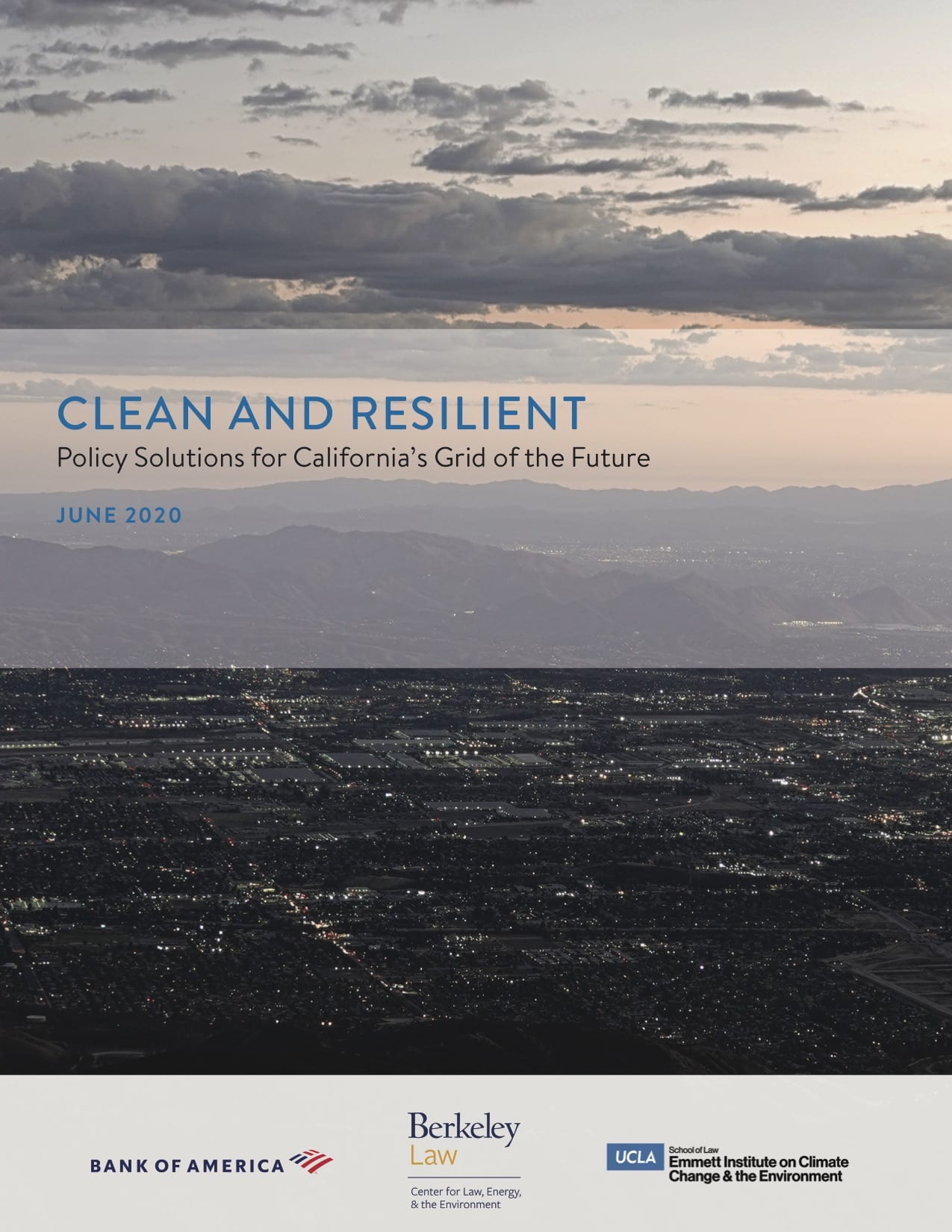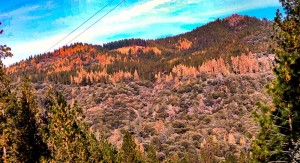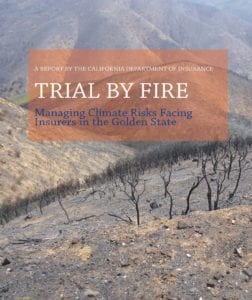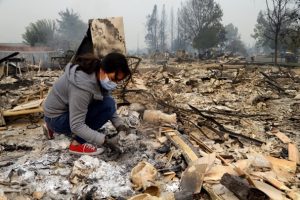Note: this post is co-authored with Ted Lamm.

California’s electrical grid is at the center of our fight against climate change, with aggressive goals to decarbonize through renewable energy. But the grid is at risk as climate impacts become more severe, particularly from worsening wildfires. To help modernize the grid to be cleaner and more resilient, the state will need deployment of clean technologies such as distributed renewable generation, microgrids, energy storage, building energy management, and vehicle-grid integration.
Part of the vulnerability of the grid stems from its role in exacerbating climate impacts. Most prominently, power lines sparked many of the record-setting wildfires of 2017 and 2018, including the Camp Fire that destroyed the town of Paradise. To minimize this threat during high-risk weather conditions, California electric utilities and energy regulators have begun to implement preemptive power shutoffs. In 2019, widespread PSPS events likely contributed to a safer wildfire season, but the days-long shutoffs also left some vulnerable communities and residents without access to essential health and safety services.
At the same time, many residents turn to fossil-fuel backup generators during grid shutoffs, which both polluting (in terms of both greenhouse gases and locally harmful air pollutants) and unaffordable for many Californians. But the alternative—deploying clean, resilient distributed resources, such as home batteries, community solar, or microgrids—will require significant policy and financial support for grid managers, electric utilities, community choice aggregators, and local governments.
To address this need, CLEE and UCLA’s Emmett Institute convened a group of California state energy regulators, local government leaders, grid experts, and clean energy advocates for a convening on California’s electrical grid of the future. CLEE and Emmett are today releasing a new report, Clean and Resilient, based on this expert group’s findings.
The report highlights the top policy solutions the group identified to address the financial, regulatory, and data barriers to clean, resilient grid deployment, including:
- Promoting performance-based regulation at the California Public Utilities Commission, to ensure that the public benefits and necessity of investments in reliable, carbon-free technology are fully accounted for.
- Reforming grid interconnection processes (including CPUC Rules 2 and 21) to create a presumption in favor of new microgrids and other distributed technologies and to equitably share the cost of associated grid upgrades.
- Initiating a new energy data collection and management process at the California Energy Commission to ensure communities, technology providers, and regulators have access to the data that will drive the grid of the future.
You can access the report and its full set of policy recommendations here. Ultimately, developing the clean and resilient electrical grid California needs will rely on a suite of parallel initiatives, from building and vehicle electrification to advanced data and communications development, each of which will require additional support. Given the range of these interconnected efforts, and the urgency of our statewide need for a safe, reliable grid, developing coordinated policy processes to promote them is becoming increasingly essential.
Pacific Gas & Electric, California’s largest investor-owned utility is about to declare bankruptcy, which could undermine the state’s climate goals. The utility faces massive liability for potentially causing the recent devastating Northern California wildfires.
If bankruptcy happens, California’s clean energy companies — from solar PV facilities to energy efficiency contractors to electric vehicle charging businesses — could soon lose one of their top customers and potentially see their existing contracts ripped up. And that means the state is losing a major investor in various climate programs.
Buzzfeed and E&E News [paywalled] covered this story in more detail, including some quotes from me.
Going forward, I hope the state and various local governments in PG&E service territory consider the following reforms:
- Break up PG&E’s electricity and gas divisions, with the long-term goal of phasing out natural gas use in the state. We mostly likely need to accomplish this phase-out anyway and move towards all-electric appliances and building. A breakup could hasten that progress.
- Buy out PG&Es assets and form municipal utilities. San Francisco is already exploring purchasing the “sticks and wires” in the city to form its own utility. Municipal utilities in the state tend to have cheaper rates and often more aggressive clean energy policies (such as Sacramento Municipal Utility District), so this could be a good move overall for ratepayers and the environment. Although it’s worth noting that PG&E is one of the cleanest utilities in California already.
- Revamp liability for wildfires going forward. Right now, whichever party is responsible for igniting a blaze is 100% liable for all damages. But what about property owners who failed to maintain and “fire-harden” their buildings? What about local officials that allow development in high-risk fire zones? What about polluting companies that caused climate change, which exacerbated the fires’ intensity? Liability should fall on these parties, too, giving them incentive to correct their actions going forward and hopefully reduce the severity of future wildfires.
These reforms would be a welcome outcome from an otherwise unfortunate situation. In the meantime though, it’s hard to foresee an outcome of PG&E’s death spiral that won’t at least temporarily slow our climate progress in California.
 The wildfires in California have state residents choking on smoke, while our neighbors in Butte County are experiencing the deadliest and worst wildfire on record. Climate change is sure to blame: record droughts and heat, coupled with a lack of autumn rain, created the ingredients for this late-season inferno.
The wildfires in California have state residents choking on smoke, while our neighbors in Butte County are experiencing the deadliest and worst wildfire on record. Climate change is sure to blame: record droughts and heat, coupled with a lack of autumn rain, created the ingredients for this late-season inferno.
But poor forest management also plays a role. In this all-too-relevant Calmatters piece from back in March, reporter Julie Cart noted that a 19th-century California forest would have held fewer than 50 trees an acre. But due to extreme logging followed by fire suppression, today’s forests now contain an unsustainable 300 to 500 trees an acre. Meanwhile, Cal Fire (the state’s fire-fighting agency) removes trees on fewer than 40,000 acres a year, far short of the stated goal of clearing 500,000 acres per year.
Thinning trees isn’t cheap. Estimates are as much as $1,400 an acre, with the controlled burns to follow costing about $150 an acre. By comparison, fighting a wildfire costs over $800 an acre, not to mention the cost to property, public health and human lives.
But we need to find a way to thin and treat these forested lands, as well as to encourage property owners to reduce their fire risk on site by clearing vegetation. We also need to encourage improved local land use decisions that avoid building in the most fire-prone areas. All tasks for our Governor-Elect Gavin Newsom to handle, once in office.
Meanwhile, I’ll be off blogging for two weeks due to various travel and work commitments. See you after Thanksgiving, when hopefully these wildfires will be gone for the season.
My former Berkeley Law colleague Steve Weissman and his twin boys Alex and Eli have an op-ed in the San Francisco Chronicle arguing that our fire prevention approach has the incentives all wrong:
For more than 100 years, land managers in the United States have treated wildfires as an ignition issue. The logic is: If we prevent wildfires from starting in the first place, the problem is solved.
Such aggressive fire suppression has also driven regulation: The person or entity legally responsible for igniting the fire faces financial consequences. This approach has brought about safer transmission lines and encouraged campers to extinguish their campfires.
Even so, mega-fires not only persist, but are larger and becoming more frequent. This is because ignitions are not the cause of bigger wildfires. Increasingly, destructive wildfires are a consequence of changing climate, mismanagement of flammable vegetation and building in fire-prone areas.
The Weissman trio recommend holding individual property owners to account for how they maintain their property. Policy makers should also plan new communities with fire breaks in mind.
Otherwise, the climate change-induced fires we’re seeing will become more severe, with the financial losses pinned on insurance companies, utilities, and property owners themselves. It certainly behooves all of us to encourage better land management by those who own their properties.
 Climate change presents a wide range of risks to California’s insurance industry, as Californians across the state contend with unprecedented wildfires, changing storm patterns, increased risks of flooding and sea level rise, and disruptions to business from agriculture to fisheries and beyond. Potential decarbonization of the economy and litigation based on climate-related damages further threaten the insurance business model. The industry faces these dynamic challenges at the same time that insurance products are becoming more necessary but less available and affordable.
Climate change presents a wide range of risks to California’s insurance industry, as Californians across the state contend with unprecedented wildfires, changing storm patterns, increased risks of flooding and sea level rise, and disruptions to business from agriculture to fisheries and beyond. Potential decarbonization of the economy and litigation based on climate-related damages further threaten the insurance business model. The industry faces these dynamic challenges at the same time that insurance products are becoming more necessary but less available and affordable.
To tackle these issues, the California Department of Insurance (CDI), under the leadership of Commissioner Dave Jones, has spearheaded efforts to drive insurers to disclose climate risks, divest of fossil fuel-related investments, and maintain access to insurance in vulnerable areas.
Today, CDI and Berkeley Law’s Center for Law, Energy and the Environment (CLEE), together with lead author Dr. Evan Mills, released Trial by Fire: Managing Climate Risks Facing Insurers in the Golden State, a comprehensive report documenting the nature and extent of the risks and opportunities faced by insurers and residents in California. The report covers:
- CDI’s landmark efforts to date;
- Physical, transition, and liability risks;
- Challenges to insurance affordability, adequacy, and availability;
- The opportunities presented by “green” insurance products;
- Potential legislative and policy reforms; and
- Solutions for industry, regulators, and consumers to preserve a viable insurance industry in a changing climate.
Many of the points covered in the report also dovetail with a June 2018 CLEE-hosted symposium with stakeholders across California’s insurance and climate regulatory communities. Building from this symposium and CDI’s ongoing climate change initiatives, Trial by Fire documents the challenges faced by an industry essential to the fight against climate change and provides a roadmap for California leaders seeking to engage and support it.
The full report is available here.
Video of Commissioner Dave Jones’ press conference this morning announcing 2018 wildfire insurance loss data and the release of the report is available here.
CDI’s press release announcing the report is available here.
 The wildfires that devastated Northern California this month claimed over 40 lives and nearly 9000 structures. But as businesses reopen and people return to their neighborhoods, what is being done to ensure future resilience in our fire-prone communities?
The wildfires that devastated Northern California this month claimed over 40 lives and nearly 9000 structures. But as businesses reopen and people return to their neighborhoods, what is being done to ensure future resilience in our fire-prone communities?
Should we rebuild in the same way, or allow more walkable, compact development? What role does water management play in the rebuilding effort? And how can you prevent fire damage to your home and property?
Join me tonight on City Visions as I discuss these issues with:
- Dr. Newsha Ajami, director of Urban Water Policy with Stanford University’s Water in the West and NSF-ReNUWIt initiatives
- Jack Cohen, retired Research Physical Fire Scientist with the U.S. Forest Service
- James Lee Witt, former director of the Federal Emergency Management Agency (FEMA) in the Clinton administration and newly named interim executive director of Rebuild NorthBay
You can tune in on KALW 91.7 FM in the San Francisco Bay Area at 7pm or stream live on the web. Hope you can join the conversation with your questions and comments!


